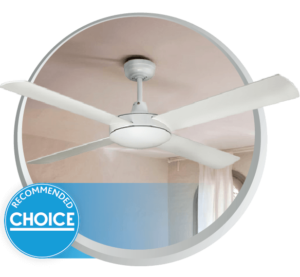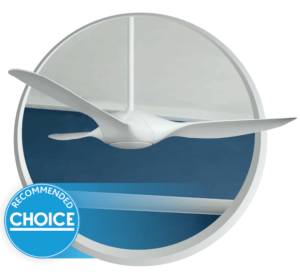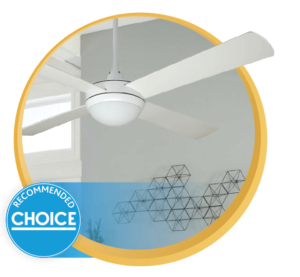Ceiling Fan Running Costs
This graph shows how much it would cost to use each appliance for six hours a day for 30 days.
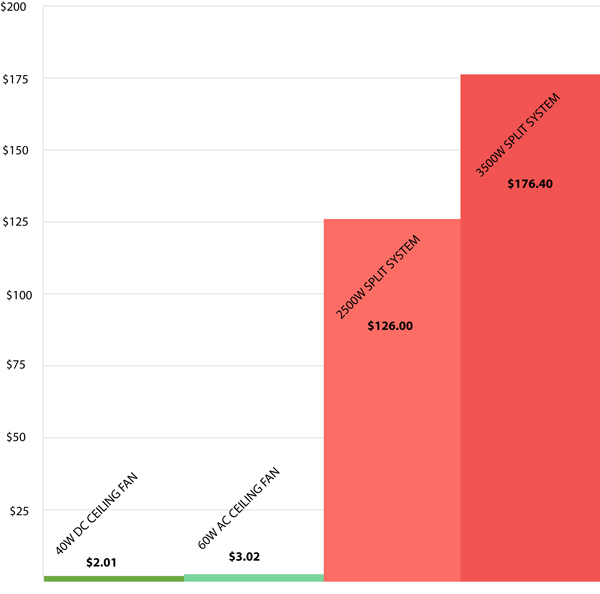
How Much Does a Ceiling Fan Cost to Run?
In comparison to either a 2500w or 3500w air conditioner, ceiling fan running costs are very low. Even high airflow fans don’t use much power, which means that the cost of running a ceiling fan is very cheap.
Working out the cost of running a ceiling fan
In Victoria, 2023, the standard ‘peak rate’ for energy is 28 cents per kilowatt hour. We used this price to calculate the running cost of ceiling fans vs split systems. As you can see, the difference is remarkable.
This graph shows how much it would cost to use each appliance for six hours a day for 30 days. Ceiling fan running costs are much cheaper.
Of course, ceiling fans and split systems do different jobs. A ceiling fan won’t give you the same effect as an air conditioner but they can still help reduce your energy bills. To take advantage of the low cost of running a ceiling fan, use it in conjunction with a split system.
The Best of Both Worlds…
Even the hottest Summers have a few days where you can get away with using ceiling fan instead of an air conditioner. You could save quite a bit of money by doing this. On very warm days, you can use ceiling fans together with your split system.
The lower you set your thermostat, the harder your air conditioner has to work. When you switch the ceiling fan on, you should be able to raise the temperature on the air conditioner by at least 1 or 2 degrees. Even a small adjustment like this reduces the amount of power you use, and cuts your electricity bill down too.
Another small change you can make is choosing an LED light. LEDs are exceptionally energy efficient compared to traditional light globes combining a cost effective Ceiling Fan with an LED light makes a lot of sense. Not only will you save money on cooling your home, you will cut your lighting expenses down too.
RUNNING COST CALCULATOR
Efficient Ceiling Fans
Efficient Fans with LED Lights
Urban 2 DC LED 52"
POWER CONSUMPTION
AIRFLOW
LIGHT POWER CONSUMPTION
LUMENS (BRIGHTNESS)
Not only is the Urban 2 DC ceiling fan extremely energy efficient, it has an optional light to match it. This 24 watt LED shines bright with an output of 1800 lumens. It is also dimmable and features Colour Changing Technology
Infinity-i DC LED 48"
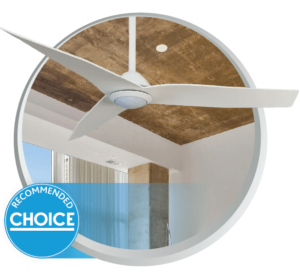
POWER CONSUMPTION
AIRFLOW
LIGHT POWER CONSUMPTION
LUMENS (BRIGHTNESS)
With just 18 watts, the Infinity-i DC LED light creates 1400 lumens. The fan itself uses less than 30 watts of power on high speed, which keeps running costs nice and low.
Power Consumption in Context vs Other Household Appliances
- DC CEILING FAN (40w)
- AC CEILING FAN (60w)
- LIGHT BULB (60w)
- FRIDGE/FREEZER (300w)
- DISHWASHER (1200w)
- SPLIT SYSTEM (2500w)
Ceiling fans cost less to run than a lot of household appliances
It’s already clear that ceiling fans cost very little to run in comparison to split systems. But they also measure up against other household appliances like fridges and dishwashers.
In this example, we’ve used a 2400 watt split system as a comparison, along with a fridge, dishwasher, an AC fan and a DC fan. To give you an idea, most AC powered ceiling fans use between 60-70 watts and DC fansconsume 30-40 watts. The wattage between products can vary though so it’s a good idea to check the power consumption on individual products.
However, all DC ceiling fans are hard to beat in terms of energy efficiency. We’ve been saying that DC ceiling fans are energy efficient for years, but this graph really shows how far ahead of the pack they really are.
AC Ceiling Fans Vs DC Ceiling Fans
Even though DC ceiling fans are exceptionally energy efficient, AC ceiling fans aren’t too far behind. With power consumption similar to a lightbulb, ceiling fans with AC motors are also power (and money) savers!


